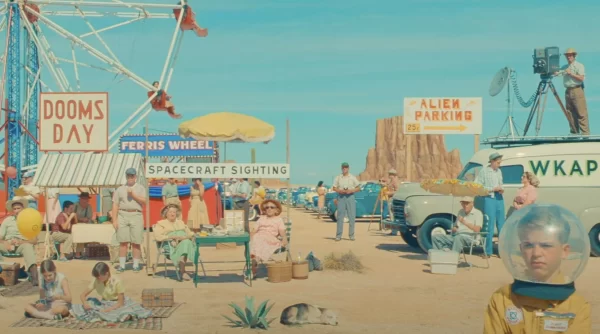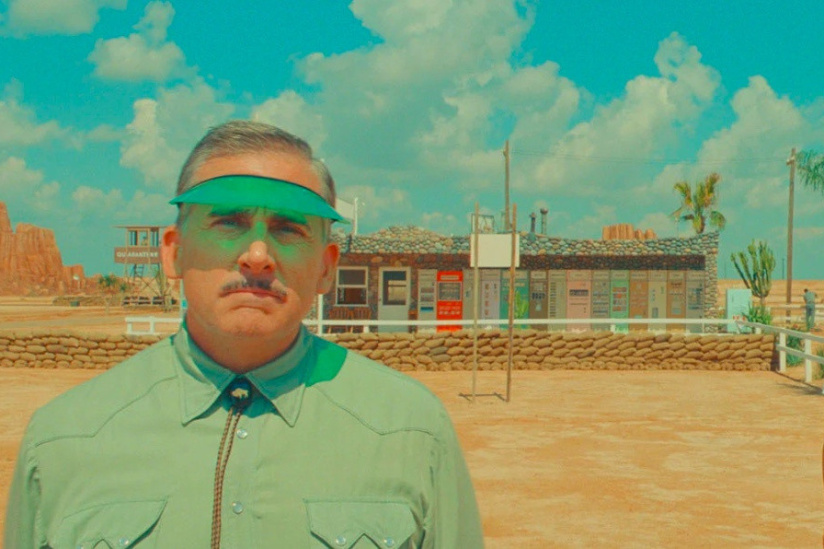With the anticipation of strange characters, dry humor and eye-catching colors, Wes Anderson never fails to create a movie that captivates the attention and love of viewers. That is until the disappointment of his new film, “Asteroid City.”
Anderson’s films are stylistic and unique, something that keeps his die-hard fans like me coming back for more, though this one seemed to miss the mark. The symmetry and comforting warm tones of “Fantastic Mr. Fox” intrigued me and kept me watching, while the unusual plot of “The Grand Budapest Hotel” egged me on until its end. While the movie theater for “Asteroid City,” however, buzzed with an occasional giggle or gasp, a hush of confused silence fell over the crowd for the duration.
The story-within-a-story of “Asteroid City” is outlined by a narrator in a theater, followed by the story of a playwright and then into his play of peculiar characters. Intending to create a film about the creation and production of a play, Anderson taps further into a whimsical and imaginative realm of storytelling. My favorite bit in the opening scenes was the description of the play’s set, which included an “unfinished highway overpass which vaults up 20 feet, then chops off midair behind a permanent roadblock.”



 However, while the purpose of a frame narrative is to provide extra context and background, “Asteroid City” only perpetuates disorder. The film opens with a fast-paced introduction of the main characters and setting, and if you aren’t paying close attention then you will miss it. As the playwright Conrad Earp quickly blocks the stage for a play, the precedent of snappy dialogue is set to be short and with little context before the viewer is thrust into the play’s story, taking place in the titular Asteroid City.
However, while the purpose of a frame narrative is to provide extra context and background, “Asteroid City” only perpetuates disorder. The film opens with a fast-paced introduction of the main characters and setting, and if you aren’t paying close attention then you will miss it. As the playwright Conrad Earp quickly blocks the stage for a play, the precedent of snappy dialogue is set to be short and with little context before the viewer is thrust into the play’s story, taking place in the titular Asteroid City.
Set in a fake barren town in western America, a “Junior Stargazers” award ceremony is held to commemorate the mysteriously advanced inventions of five peculiarly intelligent children. The main character, Woodrow Steenback, travels to the town with his father, Auggie and three silly younger sisters: a self-proclaimed vampire, mummy and fairy.
Where the film is strongest – as in all of Wes Anderson’s films – lies in his color themes and dry humor. Even by simply showing absurd set pieces such as a vending machine for real estate or an unnecessarily long fenced pathway to the asteroid landing site, the audience is able to appreciate the movie’s odd, offbeat comedy. The Tupperware containing the ashes of Woodrow’s recently deceased mother also got a laugh out of me.
While watching the film, I found myself appreciating the sets and ambiance; Anderson’s touch of uniformity and clever color grading make his film’s quote appealing to the eye with orange and blue hues. With what attracts many of his viewers being his eye-catching cinematography with symmetrical shots and satisfying costumes or sets, “Asteroid City” does not fail.

However, if humor and appearance are the only pros, then “Asteroid City” is left as a bare film. With a lackluster plot to follow, I was left wondering what I was watching or what this movie was about. Though an intriguing choice to make, the frame story of the movie rarely provided context and often cut in and out of the story of the play to the playwright’s own narrative, thus making the film difficult to understand.
Thankfully, near Act 2 of the film, the plot begins to develop during the city’s famous Asteroid Day. An alien appears from a silent UFO, carefully steals the asteroid, and disappears into the night. Transitioning into Act 3, chaos from the U.S. government about an extraterrestrial sighting ensues, making this movie slightly more flavorful.
For a viewer, halfway into the film, things are finally beginning to make sense.
Characters begin to change and attract their love interests – “Brainiac” Woodrow Steenback with Dinah Campbell, and Auggie Steenback with Midge Campbell. The couples are given monologues where they finally appear to become three-dimensional people with ambitions and backstories. One might even hope for some change in their personalities in the coming scenes.
The end of the movie came abruptly, and at the same time, too late. The character arcs were more like a “character bend” as the lover’s trope fizzled out, seeming to be where the development stopped. To me, the only “character arc” I could detect was the aforementioned three strange sisters casting a spell upon their mother’s Tupperware of ashes they buried in the dirt.
“Asteroid City” was a fine one-time watch, even for a self-proclaimed Wes Anderson fanatic like myself. Maybe with additional viewings, the depth of the story could appear clearer. Fortunately, Anderson’s bizarre story structure strengthened the filmmaker’s juxtaposed style of dysfunction and symmetry, creating an intriguing atmosphere for moviegoers. With a better plot and coherent dialogue between the different frames of the story, the film could have had a lasting impact and become a new comfort film for viewers. Instead, it was a confusing 105 minutes of mediocrity.

Note: This article was originally written for the “Stanford Daily High School Workshop.”


